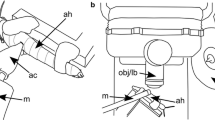Summary
-
1.
The impulse response of the tympanal membrane was determined in six species of crickets and bushcrickets by stimulating the ear with impulse sounds and recording the resulting tympanal vibration with a laser vibrometer.
-
2.
In the bushcricket ears studied the composite impulse response consists of a short, low-amplitude 20–30 kHz vibration followed by a longer, high-amplitude vibration with a ‘time constant’ of 50–60 μs (Figs. 1 and 2). The former vibration is produced by the sound impinging on the exterior surface of the tympanum, while the latter is caused by the sound travelling through the acoustic trachea. The ratio between the first and the second vibration is about 1:5. A ‘gain’ of 5 in the acoustic trachea at 20–30 kHz makes it improbable that the directionality of the tettigoniid ear is determined by pressure difference properties of the ear near the dominant frequencies of the calling song.
-
3.
The impulse response of the cricket tympanum depends on the state of the acoustic spiracles. If the ipsilateral spiracle is open, the composite impulse response is similar to that of the tettigoniid ear (Fig. 3). The ratio between the two 35–50 kHz vibrations is about 1:1.5 in two species and about 1:3.5 in two other species. If the ipsilateral spiracle is closed, the impulse response is of low amplitude, and it contains two superimposed frequencies (Fig. 4), a 50 kHz component and a 6 kHz component, the latter having a ‘time constant’ of about 185 μs. The state of the contralateral spiracle does not change the impulse response appreciably (Fig. 6).
-
4.
Impulse sounds are distorted during their transmission through the acoustic tracheal tubes, presum ably because the propagation velocity in narrow tubes is a function of frequency.
Similar content being viewed by others
Abbreviations
- IPT :
-
Ipsilateral posterior tympanum
- CPT :
-
Contralateral posterior tympanum
- IS :
-
Ipsilateral spiracle
- CS :
-
Contralateral spiracle
References
Bailey WJ (1970) The mechanics of stridulation in bush crickets (Tettigonioidea, Orthoptera). I. The tegminal generator. J Exp Biol 52:495–505
Ball EE, Hill KG (1978) Functional development of the auditory system of the cricket,Teleogryllus commodus. J Comp Physiol 127:131–138
Hill KG, Boyan GS (1977) Sensitivity to frequency and direction of sound in the auditory system of crickets (Gryllidae). J Comp Physiol 121:79–97
Kinsler LE, Frey AR (1962) Fundamentals of acoustics. Wiley, New York London
Larsen, ON, Michelsen A (1978) Biophysics of the ensiferan ear. III. The cricket ear as a four-input system. J Comp Physiol 123:217–227
Lewis DB (1974) The physiology of the tettigoniid ear. I–IV. J Exp Biol 60:821–869
Michelsen A (1981) Peripheral mechanisms of hearing in insects and lower vertebrates. Physiol Rev (in press)
Michelsen A, Larsen ON (1978) Biophysics of the ensiferan ear. I. Tympanal vibrations in bushcrickets (Tettigoniidae) studied with laser vibrometry. J Comp Physiol 123:193–203
Moiseff A, Pollach GS, Hoy RA (1978) Steering responses of flying crickets to sound and ultrasound: Mate attraction and predator avoidance. Proc Natl Acad Sci USA 75:4052–4056
Nocke H (1975) Physical and physiological properties of the tettigoniid (‘grasshopper’) ear. J Comp Physiol 100:25–57
Paton JA, Capranica RR, Dragsteen PR, Webb WW (1977) Physical basis for auditory frequency analysis in field crickets (Gryllidae). J Comp Physiol 119:221–240
Popov AV, Shuvalov VF (1977) Phonotactic behaviour of crickets. J Comp Physiol 119:111–126
Rheinlaender J, Römer H (1980) Bilateral coding of sound direction in the CNS of the bushcricketTettigonia viridissima L. (Orthoptera, Tettigoniidae). J Comp Physiol 140:101–111
Schiolten P, Larsen ON, Michelsen A (1981) Mechanical time resolution in some insect ears. I. Impulse responses and time constants. J Comp Physiol 143:289–295
Schwabe J (1906) Beiträge zur Morphologie und Histologie der tympanalen Sinnesapparate der Orthopteren. Zoologica 20 (50):1–154
Seymour C, Lewis DB, Larsen ON, Michelsen A (1978) Biophysics of the ensiferan ear. II. The steady-state gain of the hearing trumpet in bushcrickets. J Comp Physiol 123:205–216
Varjú D (1977) System theorie für Biologen und Mediziner. Heidelberger Taschenbücher. Springer, Berlin Heidelberg New York
Zeuner FE (1936) The prothoracic tracheal apparatus of Saltatoria (Orthoptera). Proc R Ent Soc Lond [Biol] 11:11–21
Author information
Authors and Affiliations
Additional information
I am most grateful to Professor Axel Michelsen for advice during the study. I thank him and Dr. Lee Miller for critically reading the manuscript. Dr. D.B. Lewis, Dr. T. Weber, and the Danish Pest Infestation Laboratory kindly provided me with animals. The work was generously supported by the Danish Natural Science Research Council.
Rights and permissions
About this article
Cite this article
Larsen, O.N. Mechanical time resolution in some insect ears. J. Comp. Physiol. 143, 297–304 (1981). https://doi.org/10.1007/BF00611165
Accepted:
Issue Date:
DOI: https://doi.org/10.1007/BF00611165




